Understanding RVCA Boards: Design and Culture
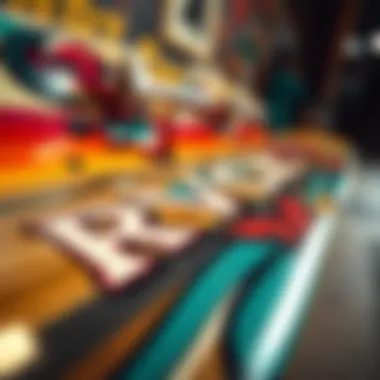
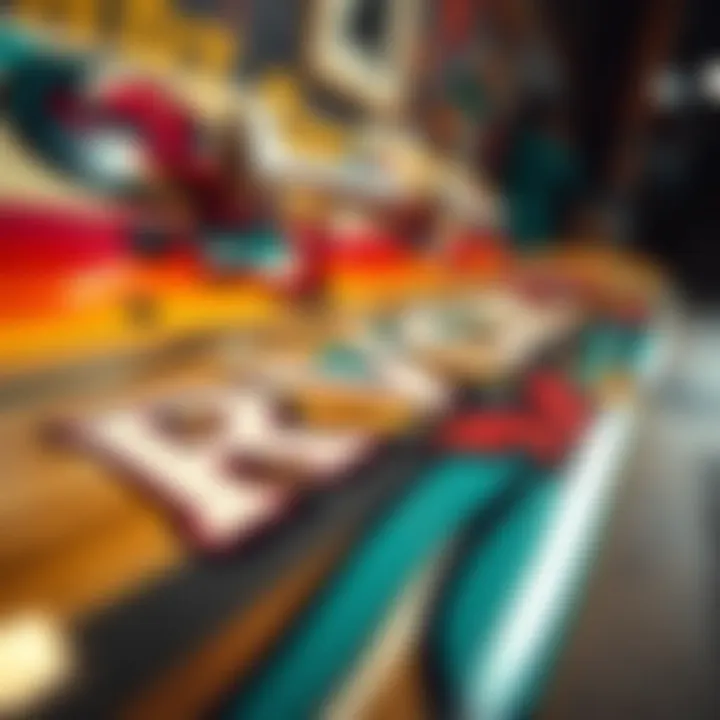
Intro
The skateboarding culture constantly evolves, with brands at the forefront pushing the boundaries of design and functionality. Among these brands stands RVCA, a name that resonates deeply within the skate community. This article unpacks the various layers of the RVCA board, revealing not just its technical specifications but also its cultural significance.
In a world overflowing with choices, the RVCA board has carved out a niche for itself thanks to its distinctive style and performance. Each board tells a story, showcasing the blend of innovation, artistry, and the spirit of skateboarding. We aim to dive into these narratives, exploring what makes RVCA boards a beloved choice among both seasoned skaters and those just taking their first ride.
Skills Development
Basic Tricks and Techniques
For those eager to start their skateboarding journey, mastering the basics lays the groundwork for future skills. Tricks like ollies and kickflips may seem daunting at first, but the right approach can ease the learning curve. RVCA boards, known for their responsiveness, allow beginners to develop balance and control. When practicing these foundational tricks, it helps to find a comfortable space free of distractions. A couple of the basic moves to consider include:
- Ollie: This is the gateway trick that many skaters learn first. Start by positioning your back foot over the tail and your front foot near the middle of the board. With a quick downward motion, pop the tail and slide your front foot up to level the board in the air.
- Kickflip: This trick builds off the ollie but adds an element of rotation. With your flick-off foot positioned at the edge of the board, push down as you pop the tail. The flick motion sends the board spinning beneath you.
Consistent practice on RVCA boards, with their sturdiness and solid grip, will help hone these skills over time.
Advanced Maneuvers and Tips
As skaters become more comfortable, they often seek to elevate their tricks to a higher standard. RVCA boards accommodate a range of advanced techniques due to their balanced construction. Some moves to tackle as you progress include:
- Board Slide: This slide involves using one or both trucks to glide across a rail or ledge. When approaching, aim for a slight angle, and let the board make contact, guiding it smoothly across the surface.
- Nosegrind: Balancing on your board’s front edge on a rail takes not just skill but also courage. Speed and commitment are key, and with practice, you’ll find you gain the right balance on your RVCA board.
Keep in mind that learning advanced tricks requires patience. Make sure to wear protective gear to avoid injuries while attempting these challenging maneuvers.
Gear and Equipment Reviews
Skateboards and Accessories
Having the right skateboard can make all the difference. The RVCA boards are often made from high-quality materials resulting in durability and performance. Look for features such as:
- Deck Composition: RVCA boards often use 7-ply maple wood, ensuring strength and a responsive feel.
- Griptape Quality: A good grip is crucial for control; RVCA’s options adhere well and provide stability during tricks.
In addition to the skateboard itself, consider accessories that enhance your skating experience. This includes everything from skate wax for smooth slides to protective gear blanketing your knees and elbows.
Safety Gear and Recommendations
When taking to the streets or ramps, safety gear is not negotiable. Investing in quality protective equipment sets the stage for a smoother and safer skating journey. Some recommended gear includes:
- Helmet: A well-fitted helmet is your first line of defense. Brands like RVCA and others offer models that combine style and safety.
- Wrist Guards: Falls are part of learning; wrist guards can prevent injuries when learning new tricks.
It's essential to not only gear yourself up but also to regularly check the condition of your equipment, ensuring everything is in top shape before hitting the pavement.
"The best skateboard isn’t the one with flashy designs; it’s the one that gives you the confidence to ride like the wind."
The next sections will delve into the historical perspective of RVCA, explore technological advancements in board designs, and reveal the cultural impact they’ve had on the skating community. What’s clear is that RVCA is not merely a brand; it's a movement within the skateboarding world.
Preamble to RVCA
The world of skateboarding thrives on more than just tricks and stunts; it’s also about the gear that skaters choose. Among the various brands populating this vibrant market, RVCA stands out with its unique offerings. Understanding RVCA isn't just about knowing a brand; it's about grasping a community, a philosophy, and a dedication to innovation that resonates with the skateboarding culture.
This section explores what makes RVCA significant for both novice and seasoned skateboarders alike. We’ll dive into its origins, fundamental principles, and the ethos that guide its design and community engagement. A deeper understanding of RVCA allows skaters to make informed choices about their boards, while parents and educators can appreciate the brand's contribution to youth culture and creativity.
The Genesis of RVCA
RVCA was founded in 2001 by a group of enthusiasts passionate about skate culture. The founders set out to create more than just skateboards; they aimed to blend art, fashion, and sport into a singular lifestyle. The genesis goes back to a simple thought of bridging gaps between various artistic forms, making each board a canvas for expression.
Key milestones in RVCA’s history include:
- The introduction of the "Artist Network Program," showcasing emerging artists.
- Collaborations with renowned skaters that pushed the envelope of board design.
- Rapid growth thanks to a grassroots marketing approach that emphasized community.
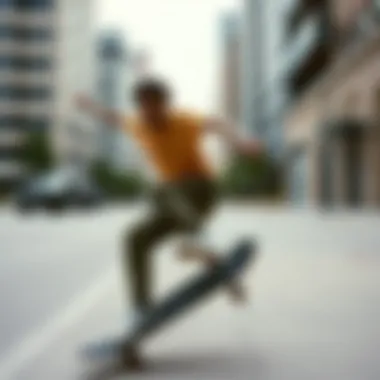
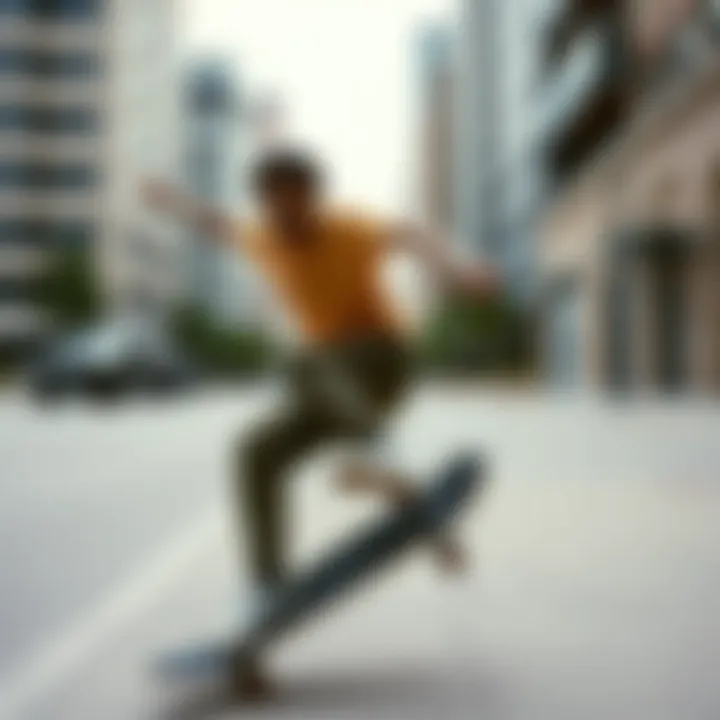
RVCA's journey reflects a broader narrative of the skateboarding scene. It encapsulates a move from purely athleticism to a recognition of skateboarding as an art form. The brand thrives today by fostering connections with diverse creative disciplines, turning ordinary skateboards into platforms of expression.
The RVCA Philosophy
At the heart of RVCA is a philosophy built on creativity, community, and commitment to quality. This guiding ethos shapes the way the brand interacts with skaters and the broader community. The RVCA slogan, "The Balance of Opposites," captures this duality perfectly, merging various elements like art and sport or individuality and community.
Understanding the RVCA philosophy involves:
- Creativity: Boards aren't just tools for skating; they're expressions of personal style. This perspective appeals to skaters who value making a statement through their gear.
- Community: RVCA prioritizes engagement by sponsoring local events, workshops, and fostering connections among skaters. Such efforts build a supportive environment where creativity can flourish.
- Quality: The brand is committed to using high-quality materials and innovative designs, ensuring that every board can withstand the demands of skating while providing an authentic experience.
By focusing on these elements, RVCA remains a pulse point for skaters around the world. The brand doesn’t just sell skateboards; it packages a lifestyle and a movement that resonates deeply with its audience. It’s about finding a balance where skaters can express themselves authentically while being part of a larger community.
Understanding Board Design
Understanding board design is crucial for anyone delving into the world of skateboarding. It's the backbone of how skaters interact with their environment and express their style. A well-designed board does more than just look good; it enhances performance, provides stability, and supports the various tricks and styles a skater may want to achieve. In this section, we’ll explore pivotal aspects such as materials, shapes, sizes, and graphics that contribute to the identity and utility of an RVCA board.
Materials Used in RVCA Boards
The backbone of any board is undoubtedly its materials. RVCA boards often employ a selection of high-grade wood, typically maple, which provides a balance of flexibility and durability. This choice facilitates a lightweight yet sturdy structure, allowing skaters to perform tricks without worrying about the board snapping under pressure. Bamboo is also gaining traction, offering an eco-friendly alternative that doesn't skimp on quality.
Using these materials ensures consistency in performance across different types of tricks and terrains. A well-constructed RVCA board can withstand the regular wear and tear that comes with skatemboarding, making it a solid investment for casual riders and pros alike.
Shape and Size Variations
When it comes to skateboards, shapes and sizes are not just about aesthetics; they dictate how a rider will interact with the board during a session.
Common Shapes
RVCA offers a variety of common shapes that cater to different skating styles. For instance, the popsicle shape is widely liked for its symmetrical design, giving skaters the ability to maneuver easily regardless of riding orientation. This feature makes it a popular choice among street skaters who often need to switch between tricks unexpectedly. On the flip side, cruiser designs offer a wider nose and tail, making them perfect for relaxed riding around town or campus.
Each shape carries its perks and slight disadvantages, depending on the skater's preferred style and the type of terrain. For example, while popsicle shapes excel in technical tricks, they may not provide the same level of comfort when cruising over long distances.
Size Chart
Sizing up a board isn't just about width; it's also about individual comfort and specific skating goals. RVCA’s size chart features various dimensions catering to different foot sizes and riding preferences. A typical wider board might be better for street skating, offering more stability for performing complex tricks. Conversely, a narrower board could be optimal for kids or those just starting out, ensuring they can better control their movements.
The size chart is an essential tool for micropicking the right board that fits each skater's unique demands, providing a roadmap to achieving their skating aspirations.
Choosing the Right Size
Choosing the right size board can feel overwhelming, especially for newcomers. One must consider foot size, height, and skill level. RVCA’s boards range from 7.5 inches to 8.5 inches, catering to various preferences. A good rule of thumb is for those with smaller feet to go for narrower boards, while bigger-footed skaters benefit from wider decks.
Additionally, this choice directly impacts how a skater achieves balance and executes tricks. A properly sized board makes riding and learning complex moves simpler and often more enjoyable.
Graphics and Artwork
Skateboard graphics do more than just beautify a dull piece of wood; they tell a story and often convey a deeper meaning, connecting skaters to culture and community.
Brand Collaborations
RVCA, known for its unique ethos, often collaborates with various brands, merging different artistic styles and making the skate culture even richer. These collaborations have blazed trails in blending subcultures, infusing the board with elements that might resonate with various audiences. With every collaboration, a piece of art is created that skaters are proud to ride and display, turning their board into a canvas.
Artist Spotlights
The Artist Spotlights within RVCA’s board designs serve to highlight individual creators’ unique perspectives. Having these artists featured not only elevates their work but also deeply engages the skate community, offering visibility to diverse styles and viewpoints. Skaters often end up feeling more connected to their boards on an emotional level when they know an artist has intimately curated the artwork, making it more than just equipment—it becomes an expression of themselves.
Performance Features
Performance features of an RVCA board are a pivotal aspect that determines its functionality and appeal among skateboarders. When considering a board, the qualities of flexibility, stability, and durability can significantly impact the riding experience. These elements are not just technical specifications; they embody the essence of what makes a skateboard responsive and enjoyable. For every skater, these features contribute to performance on various surfaces and in different skating styles. Let's delve deeper into each aspect to appreciate their importance fully.
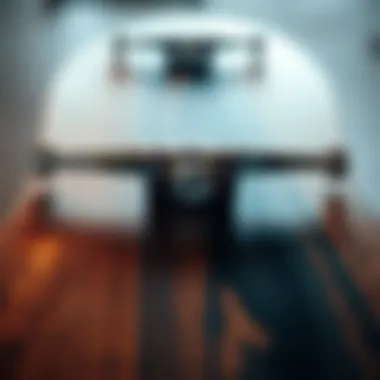

Flexibility and Stability
Flexibility helps boards withstand the strain during tricks and turns. A flexible board can absorb shocks, which reduces the risk of injury and enhances control. This quality creates a smoother ride, allowing skaters to perform a wider range of moves with finesse.
On the other hand, stability is equally essential. An adequately stable board works wonders during high-speed rides or sudden stops. The balance between these two characteristics varies among skaters’ preferences, and RVCA seems to have struck a chord by offering boards that satisfy both ends of this spectrum.
- Flexibility:
- Stability:
- Allows better control during tricks
- Absorbs shock on landing
- Adapts to the skater’s weight and style
- Increases confidence at higher speeds
- Enhances balance during complex maneuvers
Having the right mix of flexibility and stability is vital for skaters looking to optimize their performance.
Durability Testing
Durability is often the silent warrior in the world of skateboarding. The skater might not think about it until something goes wrong. RVCA boards go through rigorous durability testing to ensure they can handle everything from casual rides to extreme street skating. When a board can endure cracks, chips, and warps, it leads to better performance over time.
Manufacturers often employ different methods to test durability:
- Drop tests: Simulate various heights to check how boards respond to impacts.
- Flex tests: Measure how boards return to their original shape after bending.
- Roll tests: Assess the board’s performance over irregular surfaces.
Through these stringent tests, RVCA ensures that their boards can brave the challenges the streets will throw at them. This serves both budding skaters and seasoned pros who need a reliable ally.
Performance Feedback from Skaters
At the end of the day, there’s no better validation than feedback from those who ride the board. Professional skaters and everyday enthusiasts alike often share insights about their experience. Performance reports shed light on how a board behaves in real-world situations—from ramps to street corners, and everything in between.
Reviews provide essential data:
- Rider Experience: Many skaters emphasize how RVCA boards feel alive under their feet.
- Versatility: Feedback often highlights the adaptability of the boards across various terrains.
- Comfort: A higher comfort level generally leads to better performance, with skaters noting that extended sessions still feel good.
Listening to the user base not only fine-tunes board design but fosters a strong community connection. When skaters feel heard, it results in products that resonate with the spirit of skate culture.
“Skating isn't just about the tricks; it’s about the connection to your board and the freedom it brings.”
Cultural Significance of RVCA Boards
The cultural significance of RVCA boards goes far beyond just the materials and craftsmanship involved in their creation. These skateboards represent a lifestyle, a community, and a way of expressing individuality among skateboarders. RVCA has carved out a niche that resonates with a generation that values innovation, artistry, and rebellion, thus becoming a fundamental part of the skateboarding culture.
Influence on Skateboarding Culture
RVCA boards have undeniably left a mark on skateboarding culture. This influence is visible not just in the riding styles adopted by skateboarders but also in the way they identify with the brand's core values. The brand's philosophy pushes for creativity and freedom of expression, which resonates with skaters who view their boards as extensions of themselves.
- Artistic Collaboration: RVCA often collaborates with artists that align with its ethos, infusing the boards with unique designs. These artistic contributions serve as a canvas, allowing skaters to showcase their identity and creativity.
- Skate as Lifestyle: With RVCA, skateboarding evolved from merely a sport to a lifestyle choice in its own right. It enables skaters to embrace an attitude and aesthetic that appeals to their way of life.
- Diversity and Inclusion: The commitments of RVCA to represent various skaters through sponsorships and community events have propelled the brand further. This inclusivity fosters a sense of belonging among diverse groups within the skating community.
Community engagement is not simply an add-on for RVCA; it is central to its identity and growth within the skateboarding subculture.
Community Engagement and Events
RVCA's involvement with the skateboarding community also highlights its significance. Through various initiatives, RVCA has forged stronger connections among skaters, creating an environment that welcomes both professionals and novices alike.
- Grassroots Events: RVCA organizes skate competitions and workshops that encourage local participation. These events often showcase talented skaters who may otherwise go unnoticed in larger competitions.
- Skate Clinics: For those just starting, RVCA conducts clinics led by seasoned pros. Such initiatives provide insight into proper techniques, building skills, and boosting confidence among younger skaters.
- Pop-Up Shops and Exhibitions: These events serve to showcase RVCA boards while fostering community engagement. Fans can meet pro skaters, participate in contests, and even learn about board designs directly from artists involved with the brand.
In sum, RVCA boards are not just tools for a sport; they embody a cultural movement. The incursion into various artistic realms alongside solid community connections makes RVCA a significant player in shaping and evolving skateboarding culture. Through its efforts, RVCA promotes a lifestyle centered on creativity and inclusivity, diligently supporting the community that has embraced it.
Purchasing an RVCA Board
The purchase of an RVCA board is a significant step for any skater embarking on or continuing their journey in skateboarding. Selecting the right board not only affects performance but also expresses the skater's identity and connection to the overarching culture. This section examines essential elements to consider, where to shop, pricing, and insights into the second-hand market for RVCA boards that can guide buyers toward making informed decisions.
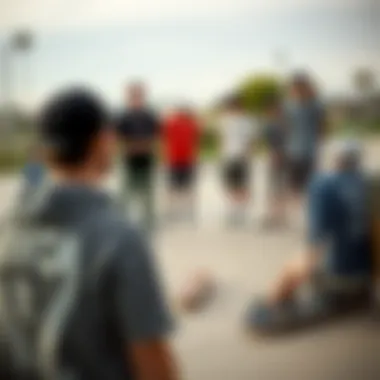
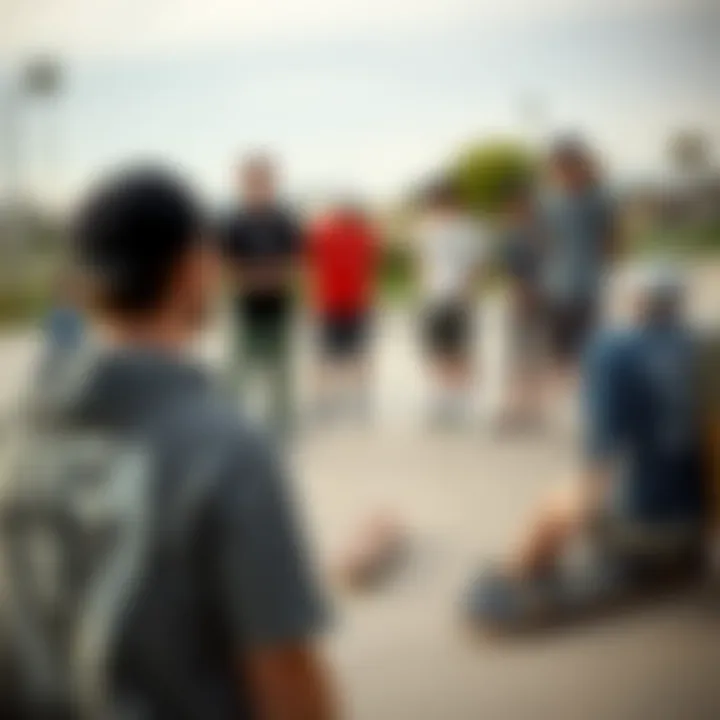
Where to Buy
When it comes to buying an RVCA board, options abound. Both physical shops and online platforms offer a plethora of choices.
- Local Skate Shops: Visiting a local skate shop can provide the advantage of personal interaction and the ability to physically examine the board before purchasing. Here, expert staff often offer insights that can guide decisions. Moreover, supporting local businesses plays a critical role in strengthening your community.
- Major Retailers: Larger sporting goods retailers such as Dick's Sporting Goods or Zumiez offer a wide selection and the chance to compare different models side-by-side.
- Online Stores: Websites like Thrive Skate Shop and Amazon make it easy to browse a vast inventory without leaving home. Be sure to check customer reviews to gauge the quality and performance of the boards.
- Official RVCA Website: The brand’s own website, RVCA.com, often has the latest models and collaborations not found elsewhere. Additionally, this route guarantees authenticity, ensuring that the product aligns with RVCA's standards.
In any case, ensuring the chosen retailer is reputable is vital. A good start might involve reading customer feedback to avoid unexpected disappointments.
"A well-informed purchase leads to enduring satisfaction. Don't rush; choose wisely."
Pricing Considerations
Understanding the price range for RVCA boards is crucial for making a prudent purchase. One has to balance quality and cost effectively. Prices can vary based on various factors such as the model, features, and retail location. Here’s a breakdown:
- Entry-Level Boards: Generally range from $50 to $100. Perfect for beginners, these boards provide foundational stability without breaking the bank.
- Mid-Range Boards: Typically priced between $100 to $200, these boards often feature enhanced durability and performance. Ideal for amateur skaters looking to elevate their skills.
- High-end Models: Offer superior craftsmanship and more advanced features, costing anywhere from $200 and up. These are aimed at professionals and serious enthusiasts willing to invest for top-notch performance.
Additionally, watch out for sales or seasonal promotions. Over time, you might also find deals during skateboarding events or brand-sponsored contests.
Second-Hand Market Insights
The second-hand market is a treasure trove for those willing to explore. Buying a used RVCA board not only saves money but also promotes sustainability within the skateboarding community. Here are some key insights:
- Condition Evaluation: Before purchasing a second-hand board, scrutinize its condition. Look for cracks in the deck, worn-out grip tape, and warping. If possible, bring a friend who knows their stuff to help assess the board.
- Local Online Marketplaces: Websites like Craigslist and Facebook Marketplace are popular places to find deals. While this might score you a great find, be cautious of potential scams.
- Skate Exchange Events: Many local skate shops and clubs host exchange events, allowing skaters to buy, trade, or sell their gear. This can be a wonderful way to meet fellow skaters while snagging a deal.
- Community Forums: Platforms like Reddit's r/skateboarding often have sections where users buy, sell, or trade gear, providing insights into fair pricing and product conditions.
Navigating the second-hand market can open doors to exceptional deals, but do your due diligence. You may just find a hidden gem that carries a story worthy of sharing on your next skater outing.
Maintaining Your RVCA Board
Keeping your RVCA board in prime condition is crucial, not just for enhancing your performance, but also for prolonging its life. When you invest in a quality board, you’re not just buying a piece of equipment; you’re adopting a crucial part of your skateboarding lifestyle. Neglecting maintenance can lead to performance hiccups, safety issues, and the need for costly replacements. Here, we’ll explore the essential aspects of maintaining your RVCA board so it can stand the test of time and constant use.
Regular Care and Maintenance
A little care goes a long way when it comes to your RVCA board. Regular maintenance basically keeps your ride smooth and can save you from big headaches down the line. First and foremost, consider the cleaning routine. Dust, dirt, and grime can build up, affecting both the grip on your deck and its visual appeal.
To keep your board looking sharp and performing its best, follow these steps:
- Wipe Down After Use: After a session, grab a damp cloth to wipe the surface of your board. This will help remove dirt and sweat.
- Inspect Regularly: Keep an eye out for any cracks or delamination. If you notice any issues, address them sooner than later.
- Store Properly: Find a cool, dry place for your board to rest when not in use. Humidity can warp the wood over time.
- Rinse Wheels and Bearings: Your wheels often graze the roughest surfaces. Rinse them with clean water to prevent debris from impacting performance.
These simple habits can prolong the life of your board and optimize your rides. Neglecting them might cut your skate sessions short, or even worse, lead to untimely equipment failure.
Repairing Common Issues
Despite your best efforts, wear and tear are unavoidable in the skate world. Knowing how to tackle common issues can save you both time and money. Here are some common problems you might encounter and how to remedy them:
- Cracked Deck: A cracked board isn't just a cosmetic issue; it can compromise your ride. If the crack is minor, often a layer of epoxy can do the trick. Apply it carefully, let it set, then sand it down until smooth.
- Wheel Issues: If your wheels feel uneven or are making noises, check for flat spots. In some cases, rotating your wheels can minimize this issue. If they’re too worn down, replacing them may be the better option.
- Sticking Grip Tape: Over time, grip tape can wear out or peel. If you notice parts are sticking up, carefully peel back and reapply or replace the tape as necessary.
- Bearing Troubles: If your board feels sluggish, check the bearings. Cleaning and lubricating them sometimes does wonders. Just a few drops of appropriate lubricant can revive their speed.
Finale
Investing time in maintaining your RVCA board not only enhances your skating experience but also fosters a deeper connection to your gear. Remember, with all aspects of skateboarding, it’s about the long haul. A well-maintained board can become a trusted companion, one that grows with you as you skate through all the seasons of life.
"A skateboard is a reflection of its owner. Care for it well, and it will carry you further than you ever dreamed."
For more details on upkeep and care, consider checking resources like Reddit, where skaters share their experiences and solutions.
Epilogue
In the realm of skateboarding, the RVCA board stands as a testament to both innovation and culture. Synthesizing the intricate details explored throughout this article, it becomes clear that the choice of board goes beyond simple functionality; it's an expression of identity and community pride among skateboarders.
Recap of Key Points
From the very genesis of RVCA to its modern-day impact on board design, we've covered how materials, shapes, and flexibility play a pivotal role in performance. The collaborative spirit that RVCA fosters with artists enriches the visual appeal of its boards, drawing in a diverse crowd of enthusiasts. In practical terms, understanding the right purchasing avenues, be it through official outlets or the second-hand market, ensures that skateboarders find not only a board that suits their style but also aligns with their budget considerations. Lastly, maintaining these boards through regular care and knowledge about repairs are vital for longevity, keeping them ride-ready for years.
Looking Ahead: The Future of RVCA in Skateboarding
As we gaze into the future, one can't help but wonder how RVCA will continue to evolve within the skateboarding scene. The brand's commitment to pushing boundaries through innovative materials and designs speaks to its forward-thinking mindset. With the ongoing rise of technology in sports, it's plausible that RVCA will incorporate smart features into their boards, optimizing performance metrics for skaters. The community aspect appears poised to grow as well, with more grassroots events and collaborations on the horizon, aimed at engaging skaters of all ages and backgrounds.
"In skateboarding, as in life, it’s not just about the destination; it's about how you ride the journey."
In summary, RVCA boards are more than just a means of transport—they are a culture, a community, and a continuously evolving craft that will likely reflect wider changes in the skateboarding lifestyle for years to come. As these trends emerge, it will be fascinating to see how RVCA adapts, ensuring its place at the forefront of skateboarding culture.







